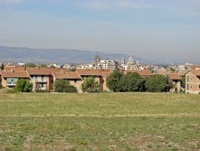


Foligno in the Iron Age
The plain around Foligno was once the site of a lake known as the Lacus Umber. (The Romans drained this lake and settled the area, but it reverted to swamp after the fall of the Roman Empire and was not drained again for many centuries).
Archeological evidence for the Umbrian settlement around this lake in the Iron Age is scant:
-
✴Excavations have revealed a necropolis (7th century BC) at Via Po and another necropolis (5th century BC) near the church of the Madonna del Sasso, both of which are near the archaeological area near Santa Maria in Campis (across the railway line from the centre of modern Foligno). These necropoles were probably on the shore of the lake, and votive statues found nearby suggest that this was also the site of a sanctuary.
-
✴Traces of hill forts have been identified on Monte Pale, which overlooks the plain from the east.
-
✴Bronze votive offerings (6th 3rd century BC) found at Cancelli (south of the modern city) indicate that this was the site of another sanctuary.
Grave goods from the necropoles and some votive bronzes from Cancelli are displayed at the Museo della Città, Palazzo Trinci, Foligo.
Roman Conquest
Livy recorded that, during the Roman war against the Samnites and their Etruscan allies in 308 BC, another ethnic group that he designated “the Umbrians” threatened to march on Rome. The consul Quintus Fabius Maximus Rullianus:
-
“... by forced marches proceeded to Mevania [modern Bevagna], where the forces of the Umbrians then lay. The unexpected arrival of [Fabius] ... so thoroughly frightened the Umbrians that several advised retiring to their fortified towns and others [urged] the discontinuation of the war. However, one district, called by themselves Materina [an unknown location], prevailed on the rest not only to retain their arms, but to come to an immediate engagement. They fell upon Fabius while he was fortifying his camp. [Fabius assembled his men and exhorted them] to finish this insignificant appendage to the Etrurian war, and to take vengeance for the impious expressions in which these people had threatened to attack the city of Rome. [Such was the effect of his rhetoric that his army stormed to victory and] the Umbrians called on each other, with one voice, to lay down their arms. Thus a surrender was made in the midst of action by the first promoters of the war; and on the next and following days, the other states of the Umbrians also surrendered” (‘Roman History’, 9:41).
It seems likely that the people that the Romans later designated as the ‘Fulginiates’ had contributed to the forces assembled in nearby Mevania, and thus that they were among the communities that surrendered to the Romans after this ignominious defeat. The Umbrians (or, at least, a significant Umbrian element) nevertheless subsequently allied themselves with the Samnites, and suffered a final blow to their independence with the Roman victory in the Battle of Sentium in 295 BC.
Read more:
L. Bonomi Ponzi, "La Necropoli Plestina di Colfiorito di Foligno", (1997) Perugia
C. Lorenzini and M. Romana Picuti, "Il Popolo degli Umbri: Plestini e Fulginates", (2003) Foligno (This work is written for a young audience and is well illustrated, so it is accessible to anyone with a reasonable grasp of Italian).
Return to History of Foligno

